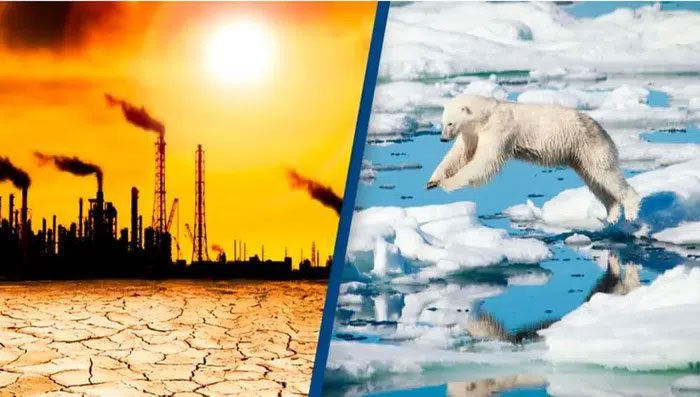The World Meteorological Organization (WMO) recently issued a warning that there is a 50% chance the global average temperature will reach 1.5 degrees Celsius within the next five years (by 2026) compared to pre-industrial levels.
1.5 degrees Celsius is a critical threshold that scientists have identified as a limit beyond which the Earth may face severe climate change impacts.
However, such a temperature increase would only be temporary in 2026, as researchers remain concerned about the trajectory of temperature increases.
According to the Paris Agreement on climate change, countries have committed to limiting temperature rises to 2 degrees Celsius and striving to keep it at 1.5 degrees Celsius compared to pre-industrial levels to avoid the most dangerous impacts of climate change.
The WMO noted that in 2015, when the Paris Agreement was signed, the likelihood of temperatures exceeding 1.5 degrees Celsius was nearly zero. However, compared to seven years ago, WMO’s research has provided additional evidence that the rate of global warming is accelerating at an alarming rate.
The WMO believes that the probability of average temperatures exceeding 1.5 degrees Celsius for a short period has increased since 2015. Scientists estimate the likelihood of additional global temperature increases to be between 20% and 40% by 2021.
Specifically, the world experienced increased flooding, storms, heatwaves, and wildfires due to climate change in 2021. Weather patterns have become more extreme, crop yields are expected to suffer, and critical systems such as coral reefs have also faced significant losses, along with a reduction in Arctic ice cover.
Notably, if global temperatures exceed 1.5 degrees Celsius, it will threaten several countries around the world.

Global temperatures could exceed 1.5 degrees Celsius by 2026. (Photo: Istockphoto)
According to Dr. Leon Hermanson from the UK Met Office: “Our latest climate predictions indicate that global temperatures will continue to rise, with the possibility that one of the years from 2022 to 2026 could exceed 1.5 degrees Celsius compared to pre-industrial levels.”
Dr. Hermanson added that a single year exceeding 1.5 degrees Celsius does not mean we have violated the symbolic threshold of the Paris Agreement on climate change. However, it does indicate that we are getting closer to a scenario where temperatures could exceed 1.5 degrees Celsius for an extended period.
The WMO’s preliminary report on the State of the Global Climate indicates that in 2021, the global average temperature was 1.1 degrees Celsius higher than pre-industrial levels. The final report from the WMO will be officially released on May 18.
According to warnings from the WMO and the Met Office, there is about a 48% chance that annual temperatures on Earth will exceed 1.5 degrees Celsius compared to pre-industrial levels by 2026.
Significant Impacts of Climate Change
The Met Office states that the Arctic will bear the brunt of climate change, as warming in this region is expected to be three times greater than the global average temperature increase during the upcoming winter over the next five years.
WMO Secretary-General Petteri Taalas stated that this research shows we are getting closer to temporarily reaching the lower target of the Paris Agreement on climate change. The 1.5 degrees Celsius increase is not a random statistic; it is more of an indicator of a threshold beyond which climate impacts will increasingly become harmful to humanity and the entire planet.
“As long as we continue to emit greenhouse gases, temperatures will keep rising,” Professor Petteri Taalas emphasized.

Climate experts warn that global temperatures are nearing the “danger” threshold. (Photo: Alamy)
Furthermore, according to Professor Petteri Taalas, the rising temperatures will also cause oceans to become warmer and more acidic; ice and glaciers will continue to melt, sea levels will keep rising, and weather will become more extreme.
Additionally, the La Niña phenomenon occurring at the beginning and end of 2021 has had a temporary cooling effect on global temperatures. However, experts believe this is only temporary and will not reverse the long-term warming trend worldwide.
The main content of the Paris Agreement on climate change is to limit global warming to below 2 degrees Celsius while striving for a more ambitious target of 1.5 degrees Celsius compared to pre-industrial levels.
Maxx Dilley, Deputy Director of the WMO, stated that the losses and damages associated with climate change are already occurring and some of them may be irreversible in the near future.
Previously, world leaders committed to adhering to the 2015 Paris Agreement to prevent global temperatures from exceeding 1.5 degrees Celsius in the long term. However, to date, countries have yet to fulfill their commitments to reduce emissions, which is one of the main causes of global warming.
In fact, current activities and existing policies worldwide are trending toward a warming of about 3.2 degrees Celsius by the end of this century.
Dr. Kim Cobb, a climate expert at the Georgia Institute of Technology, stated: “It is important to remember that once we reach the 1.5 degrees Celsius threshold, we will face worse impacts as temperatures continue to rise to 1.6 degrees Celsius, 1.7 degrees Celsius, and beyond.”
Earlier, at the COP26 climate summit in Glasgow, Scotland, in November 2021, over 80% of countries agreed to adopt net-zero emissions targets. However, in practice, there has been very little policy action to achieve these goals.
Dr. Andrew King, a climate science lecturer at the University of Melbourne, noted that the WMO report highlights how quickly humans are warming the planet.
“Our greenhouse gas emissions remain at record high levels. Even until emissions are reduced to net zero, we will continue to witness global warming,” Dr. Andrew King stated.
According to the Intergovernmental Panel on Climate Change (IPCC), net-zero emissions occur when human-caused CO2 emissions are balanced globally by removing CO2 over a certain period. In other words, net-zero emissions require balancing the amount of greenhouse gases humans emit into the atmosphere with the amount that is removed from it.
To achieve this balance, we can utilize technologies or plant trees to absorb CO2 from the atmosphere.
Dr. Andrew King emphasized that the Paris Agreement on climate change aims to keep the Earth’s warming below 2 degrees Celsius and ideally below 1.5 degrees Celsius over the long term. The possibility of exceeding the 1.5 degrees Celsius threshold, even for just one year, is highly concerning.
Therefore, without efforts to reduce greenhouse gas emissions, we will face much worse heatwaves and wildfires, as well as coral reefs being devastated beyond recognition.
Bob Ward, Director of Policy at the Grantham Institute for Climate Change and the Environment, remarked that these forecasts indicate we are very close to the limits where most experts and governments have concluded that the risks of impacts will be at an unacceptable high level.
While there is no evidence that a global disaster will occur immediately when global temperatures reach 1.5 degrees Celsius, this could cause significant harm to many countries through extreme phenomena such as flooding and heatwaves.
|
CO2 is one of the greenhouse gases that significantly contributes to global warming. Once CO2 is released into the atmosphere, it will persist there and warm the Earth for decades. In fact, CO2 is primarily emitted from burning fossil fuels such as coal and oil. Current CO2 levels have significantly accelerated due to human-caused pollution. At COP26, nearly 150 countries committed to achieving net-zero emissions by mid-century; over 100 countries joined the Global Methane Pledge to reduce methane emissions by 2030; more than 140 countries participated in the Glasgow Leaders’ Declaration on Forests and Land Use; over 48 countries joined the Global Declaration on the Transition from Coal to Clean Power; and more than 150 countries participated in the Global Action Alliance on Climate Adaptation. |


















































